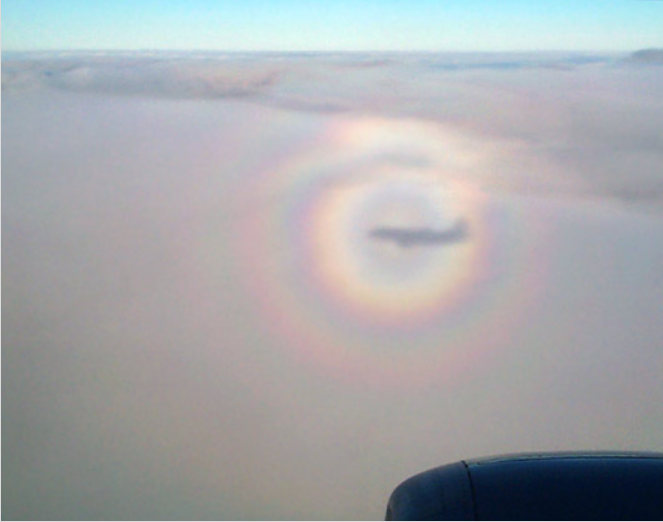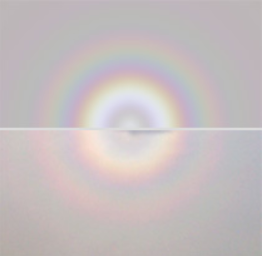Glories from the Air
Glories from the Air: A Mesmerizing Atmospheric Phenomenon
Glories, those captivating optical phenomena, often grace our view from the air. Picture yourself in an aircraft, with the sun as your celestial companion. As you gaze out of the window, you may witness a remarkable sight - a multi-ring glory encircling the shadow of the aircraft. It's as if a halo of ethereal beauty is embracing the space where your own shadow would be. These mesmerizing glories captivate our attention and leave us in awe of the wonders of the atmosphere.
The phenomenon of glories is a captivating interplay between light, water droplets, and our perspective from above. Each passenger on the aircraft has their own unique vantage point, allowing them to witness their own personal glory. It's fascinating to think that even without seeing the engine in the foreground, one could deduce the seating arrangement based on the position of the glory. Such is the enchanting nature of these atmospheric marvels.
Let's delve into the details of a particularly exceptional glory captured by Philip Laven during a flight between Frankfurt and Geneva in November 2000. This glory stood out due to its unusually large size, featuring three distinct rings with red diameters measuring 8.2, 14.6, and 20 degrees. To gain further insight into this phenomenon, Laven employed Mie theory simulation using IRIS (the Imaging and Radiometric Image Simulator). The simulation revealed that the cloud droplets in the foreground cloud were nearly monosized, with diameters measuring 9.6 microns (0.0096 mm).
Glories are formed through a process known as diffraction, where light waves bend and spread as they encounter tiny water droplets suspended in the air. The droplets act as miniature prisms, refracting and dispersing sunlight into its constituent colors. As a result, we perceive the glory as a series of colorful rings surrounding the shadow of the aircraft. The exact size and appearance of the glory depend on various factors, including the size and uniformity of the droplets, the angle of the sunlight, and the observer's position.
To better understand the formation of glories, let's explore the steps involved:
- Sunlight passes through a layer of clouds or mist containing tiny water droplets.
- The light waves encounter these droplets, and some of them are refracted and dispersed.
- The refracted light waves then undergo constructive interference, leading to the formation of a bright central region in the glory.
- Surrounding the central region, a series of concentric rings appear due to additional interference patterns.
- The colors we perceive in the glory result from the varying wavelengths of light being diffracted and interfering with one another.
- The size and intensity of the glory depend on factors such as droplet size, droplet concentration, and the observer's position relative to the light source and droplets.
Glories are not limited to aircraft observations alone. They can also be seen from mountaintops, high buildings, or even from an airplane window on a cloudy day. However, witnessing a glory from an aircraft provides a unique perspective, as we are positioned above the clouds and have an unobstructed view of the phenomenon. It's a truly awe-inspiring experience that showcases the harmonious dance between light and water in our atmosphere.
In conclusion, glories from the air are a captivating manifestation of atmospheric optics. These enchanting rings of light encircle the shadow of an aircraft, creating a spectacle that captivates passengers and fills them with wonder. Through diffraction and interference, sunlight interacts with tiny water droplets suspended in the air, resulting in the formation of colorful concentric rings. Each passenger has their own personal glory, adding to the mystique of this atmospheric phenomenon. So, next time you find yourself soaring through the sky, keep an eye out for the mesmerizing glories that may grace your view and remind you of the beauty that lies above the clouds.

A Multi-ring glory surrounds an aircraft's shadow.
Glories are often seen from aircraft. Get a seat opposite the sun and watch them ring the aircraft's shadow - or more accurately, where your own shadow would be.
Each sees their own glory. We could tell Philip Laven (site) was seated forward of the wing even if the engine were not visible in the foreground.
Taken between Frankfurt and Geneva, Nov 2000.
©2000 Philip Laven, used with permission.

This glory was unusually large. Its three rings had (red) diameters of 8.2, 14.6 and 20°. The Mie theory simulation using IRIS shows that the cloud droplets in the foreground cloud were almost monosized with diameters of 9.6 micron (0.0096 mm).
Note: this article has been automatically converted from the old site and may not appear as intended. You can find the original article here.
Reference Atmospheric Optics
If you use any of the definitions, information, or data presented on Atmospheric Optics, please copy the link or reference below to properly credit us as the reference source. Thank you!
-
<a href="https://atoptics.co.uk/blog/glories-from-the-air/">Glories from the Air</a>
-
"Glories from the Air". Atmospheric Optics. Accessed on April 27, 2024. https://atoptics.co.uk/blog/glories-from-the-air/.
-
"Glories from the Air". Atmospheric Optics, https://atoptics.co.uk/blog/glories-from-the-air/. Accessed 27 April, 2024
-
Glories from the Air. Atmospheric Optics. Retrieved from https://atoptics.co.uk/blog/glories-from-the-air/.